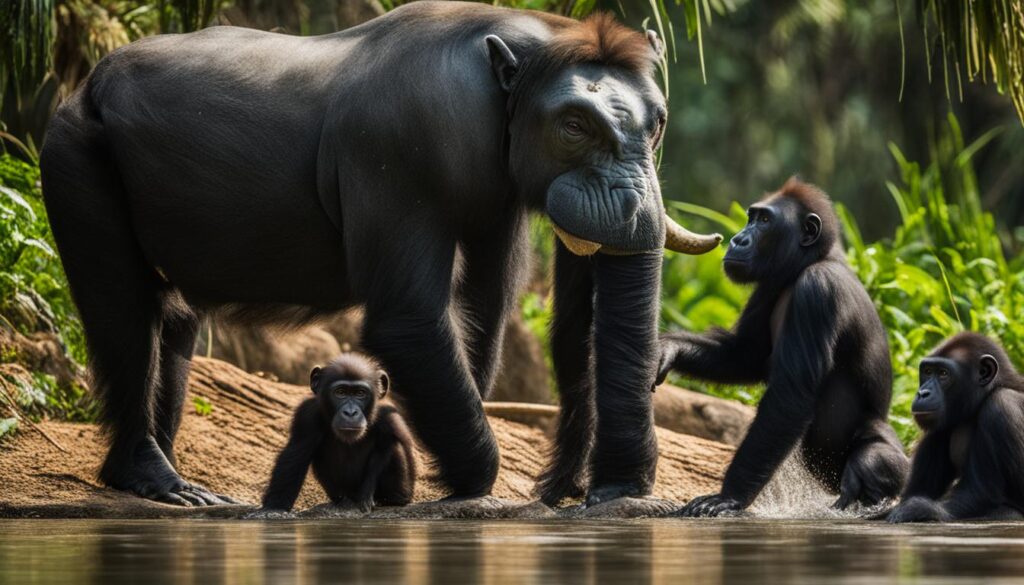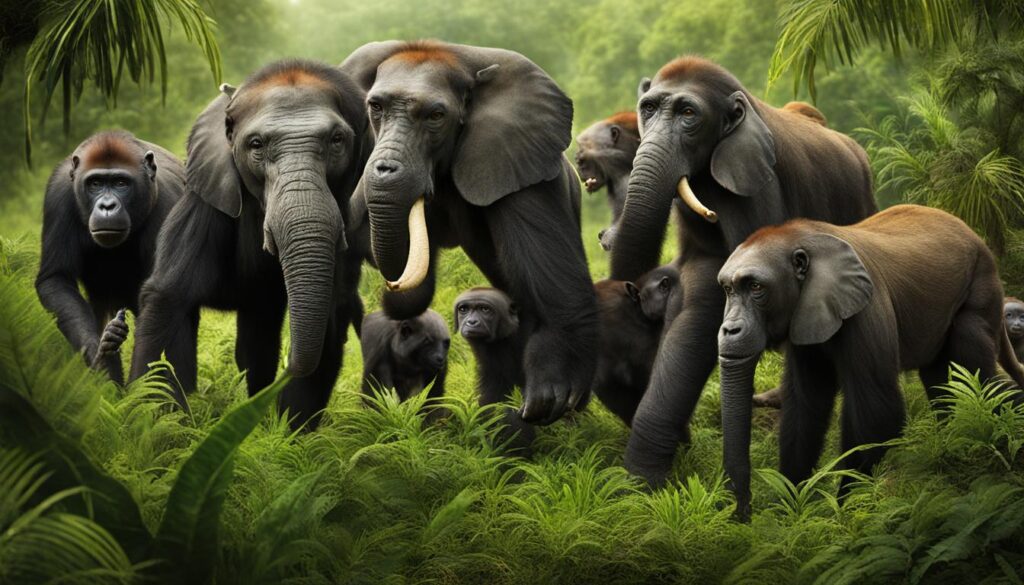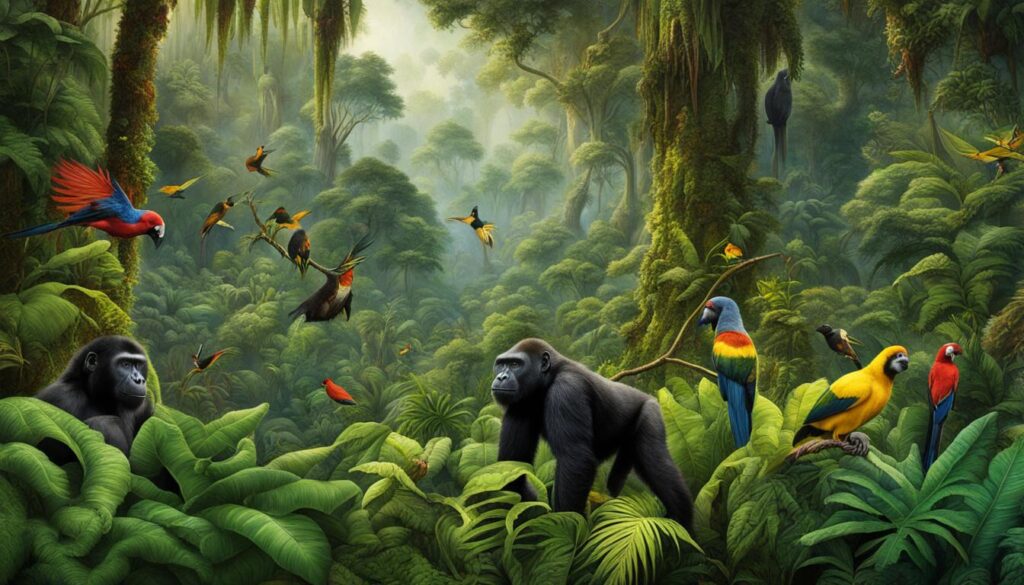The Democratic Republic of the Congo (DRC) is a country known for its remarkable wildlife and diverse animal species. Located in Central Africa, the DRC is home to one of the most biodiverse habitats on the planet, encompassing rainforests, seasonally flooded forests, and grasslands.

Within these rich ecosystems, you can find an astonishing array of animal life. From majestic forest elephants to elusive bonobos and endangered gorillas, the DRC is teeming with fascinating creatures. The biodiversity of the country is nothing short of astounding, with over 10,000 plant species, 600 timber species, 1,000 bird species, 280 reptile species, and 400 mammal species.
However, the conservation of wildlife in the DRC is facing significant challenges. Factors such as overhunting, deforestation, and armed conflict pose threats to the survival of many animal species. Despite these challenges, the DRC has taken steps to protect its natural heritage through the establishment of national parks and wildlife reserves.
Key Takeaways:
- The Democratic Republic of the Congo is home to diverse and unique animal species.
- The country’s rich biodiversity includes over 10,000 plant species and 400 mammal species.
- Conservation efforts face challenges such as overhunting, deforestation, and armed conflict.
- National parks and wildlife reserves play a crucial role in protecting the country’s wildlife.
- Preserving the biodiversity of the DRC is essential for the long-term survival of its animal species.
Biodiversity Hotspots
The Democratic Republic of the Congo is considered a biodiversity hotspot, with its rainforests harboring many rare and endemic species. The country has five national parks listed as World Heritage Sites by UNESCO, including the Garumba, Kahuzi-Biega, Salonga and Virunga National Parks, and the Okapi Wildlife Reserve. These protected areas are home to a variety of wildlife and play a crucial role in their conservation.
However, wildlife conservation in the DRC faces significant challenges due to issues such as overhunting for bushmeat, deforestation, mining, and armed conflict. These factors have put the country’s biodiversity at risk and have resulted in the endangerment of many species.
“Conserving the extraordinary biodiversity of the Democratic Republic of the Congo is of utmost importance. The rainforests and national parks in the country are beautiful landscapes that need our protection for the benefit of both the wildlife and future generations.”
The biodiversity hotspots in the DRC not only provide crucial habitats for endangered wildlife but also hold immense potential for ecotourism. Wildlife sanctuaries such as the Garumba, Kahuzi-Biega, Salonga and Virunga National Parks, and the Okapi Wildlife Reserve offer unique experiences for nature enthusiasts, making Congo wildlife tours a sought-after adventure.
By promoting responsible tourism and supporting wildlife conservation efforts, visitors can contribute to the preservation of the DRC’s rich biodiversity. Protecting these hotspots allows endangered wildlife to thrive and ensures that future generations can continue to appreciate the beauty of the Congolese wilderness.
Native Animal Species
The Democratic Republic of the Congo is home to a wide range of animal species, showcasing the incredible Congo animal biodiversity. From majestic primates to mighty mammals, the diverse habitats of the DRC support a rich variety of fauna. Let’s explore some of the notable native animals that call this region their home.
Gorillas: Western Lowland and Eastern Lowland
One of the most iconic inhabitants of the DRC is the gorilla. The country is home to both western lowland gorillas and eastern lowland gorillas, which are subspecies of the larger gorilla family. These gentle giants are known for their strength, intelligence, and close-knit social structures.
African Forest Elephant
The Democratic Republic of the Congo is also home to the African forest elephant, one of the two identified African elephant species. These elephants have adapted to life in the dense rainforests of the region and play a crucial role in maintaining the ecosystem’s balance.
Okapi
The DRC is the only country in the world where the elusive okapi can be found. With its striking appearance resembling a mix of zebra and giraffe, this unique animal is often referred to as the “forest giraffe.” The okapi is a living testament to the incredible biodiversity found in the Congo.
Alongside these notable species, the Democratic Republic of the Congo is also home to a diverse array of animals, including the aardvark, African buffalo, African elephant, African leopard, African rock python, bonobo, chimpanzee, Nile crocodile, and hippopotamus. This remarkable variety highlights the wealth of animal species Congo has to offer.
However, with the increasing threats of habitat loss, poaching, and other human-induced activities, many of these animals are facing significant challenges to their survival. The importance of wildlife conservation efforts in the DRC cannot be overstated; these efforts are essential in safeguarding the future of these unique and precious animals.

In the midst of this rich animal biodiversity Congo possesses, it is vital that we take action to protect and preserve these incredible creatures for future generations to enjoy.
Flora and Fauna Diversity
The Democratic Republic of the Congo is home to a remarkable diversity of flora and fauna. The country’s equatorial rainforest is a haven for a wide range of plant species, including towering trees such as African oak, red cedar, walnut, and mahogany. The lush rainforest also supports an abundance of undergrowth plants and vines, creating a thriving ecosystem.
In addition to the rainforest, the coastal regions and eastern swamps of the DRC showcase unique vegetation. Coconut palms, mangrove forests, and tall grasses dominate these areas, contributing to the country’s rich biodiversity. On the plateaus and in the Niari valley, grasslands and scattered broad-leaved trees form the landscape.
This diverse array of habitats within the DRC supports an impressive array of animal life. The region is home to iconic species such as chimpanzees, gorillas, elephants, and okapis. Other notable fauna found in the country include wild boars, buffaloes, antelopes, and various species of birds.

The combination of abundant plant and animal species makes the Democratic Republic of the Congo a truly unique and important region for biodiversity. However, the preservation of this biodiversity is of utmost importance as many species face threats from factors such as deforestation, overhunting, and armed conflict. Protecting the diverse flora and fauna of the DRC is essential for maintaining the ecological balance and ensuring a sustainable future for the country.
Conclusion
The Democratic Republic of the Congo is renowned for its rich biodiversity and unique animal species. With its diverse range of wildlife, including iconic gorillas, elephants, bonobos, and okapis, the country stands as a biodiversity hotspot. However, the preservation of these animals is of utmost importance due to the challenging factors they face, such as overhunting, deforestation, and armed conflict.
Efforts to protect and conserve the country’s wildlife and biodiversity are critical for the survival of these species. National parks and wildlife reserves, such as the Garumba, Kahuzi-Biega, Salonga and Virunga National Parks, and Okapi Wildlife Reserve, play a vital role in safeguarding the natural heritage of the DRC. These protected areas offer sanctuaries for animals and create opportunities for research, conservation, and tourism.
Continued conservation efforts, combined with raising awareness about the importance of wildlife conservation, can help ensure the thriving future of the animals in the Democratic Republic of the Congo. By addressing the challenges posed by overhunting, deforestation, and armed conflict, we can strive towards a sustainable future where wildlife and humans coexist harmoniously.
FAQ
What animal species can be found in the Democratic Republic of the Congo?
The Democratic Republic of the Congo is home to over 10,000 plant species, 600 timber species, 1,000 bird species, 280 reptile species, and 400 mammal species. Notable animals include the forest elephant, gorilla, forest buffalo, bongo, and okapi.
Are there any endangered wildlife species in the Democratic Republic of the Congo?
Yes, many animal species in the DRC are threatened, including the large lowland gorillas and chimpanzees.
What efforts are being made to preserve wildlife in the Democratic Republic of the Congo?
Conservation efforts in the DRC are underway in the form of national parks and wildlife reserves, such as the Garumba, Kahuzi-Biega, Salonga and Virunga National Parks, and Okapi Wildlife Reserve.
What are the challenges faced in wildlife conservation in the Democratic Republic of the Congo?
Wildlife conservation in the DRC faces challenges such as overhunting, deforestation, and armed conflict.
Why is the Democratic Republic of the Congo considered a biodiversity hotspot?
The DRC is considered a biodiversity hotspot due to its rainforests harboring many rare and endemic species. The country has five national parks listed as World Heritage Sites by UNESCO, including the Garumba, Kahuzi-Biega, Salonga and Virunga National Parks, and the Okapi Wildlife Reserve.
What are the threats to wildlife conservation in the Democratic Republic of the Congo?
Overhunting for bushmeat, deforestation, mining, and armed conflict are significant threats to wildlife conservation in the DRC.
What animal species are native to the Democratic Republic of the Congo?
The DRC is home to a wide range of native animal species, including the western lowland gorilla, eastern lowland gorilla, African forest elephant, and okapi.
How diverse is the flora and fauna in the Democratic Republic of the Congo?
The varied habitats of the DRC support a rich variety of fauna, including primates, reptiles, and mammals. The country’s equatorial rainforest is home to towering trees such as African oak, red cedar, walnut, and mahogany, while coastal regions and swamps are characterized by coconut palms, mangrove forests, and grasses.
